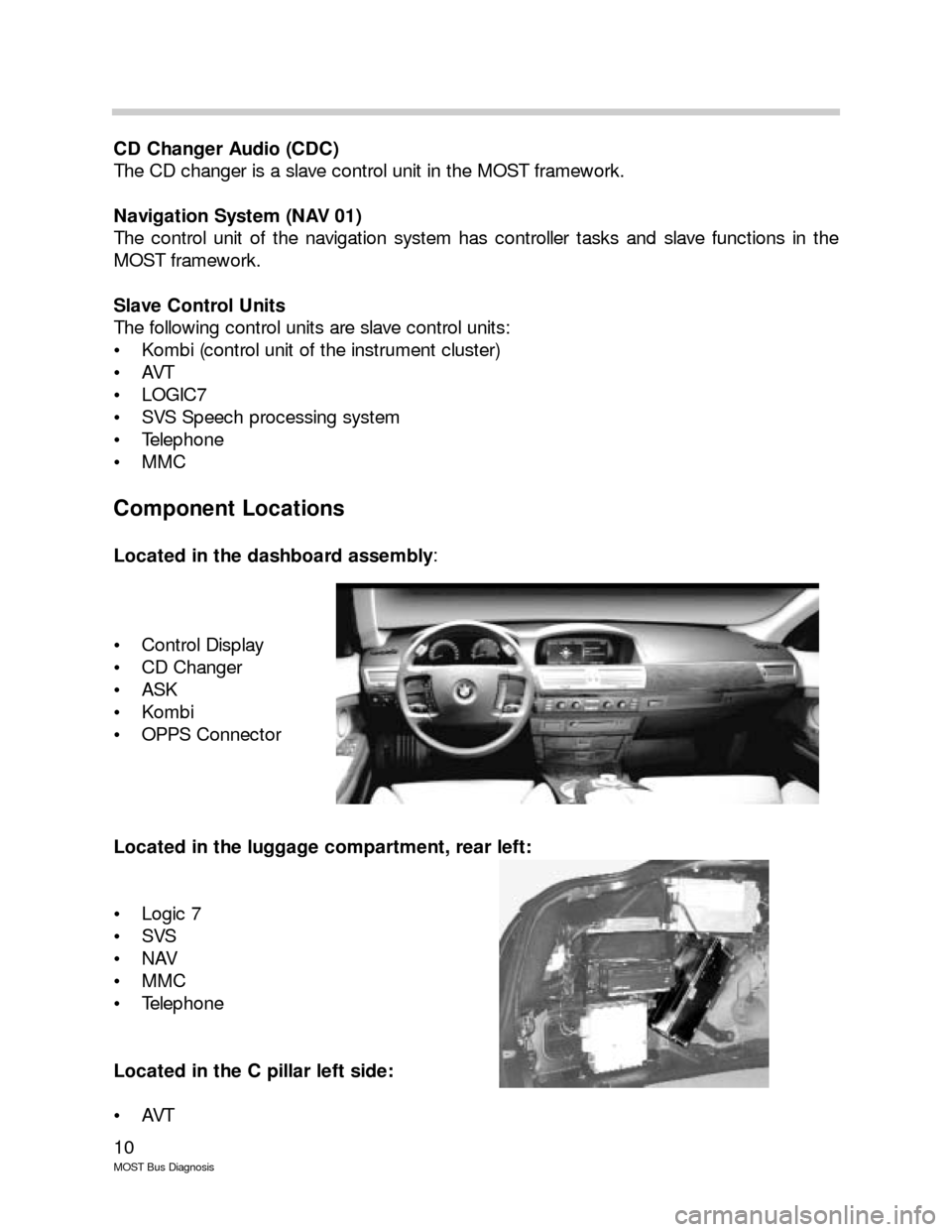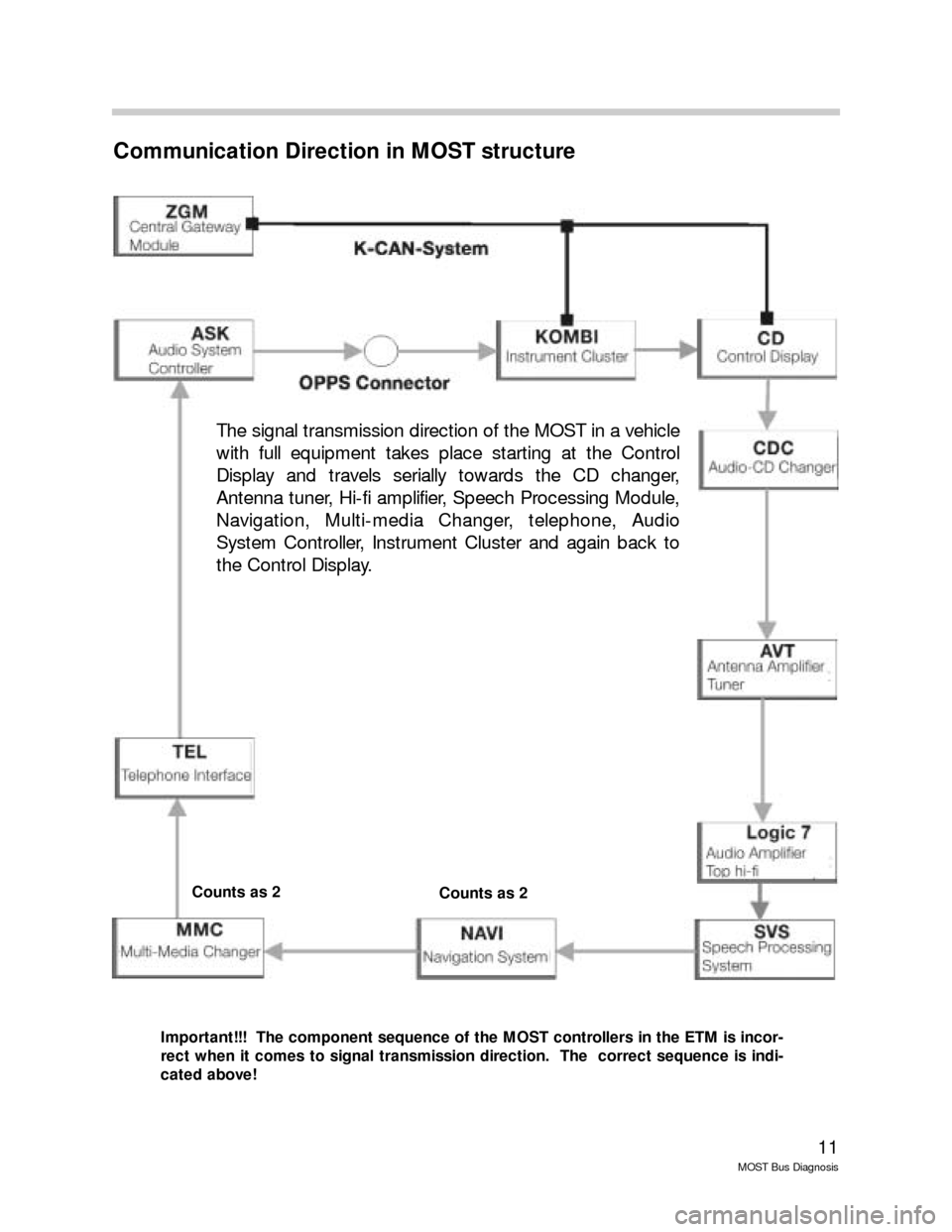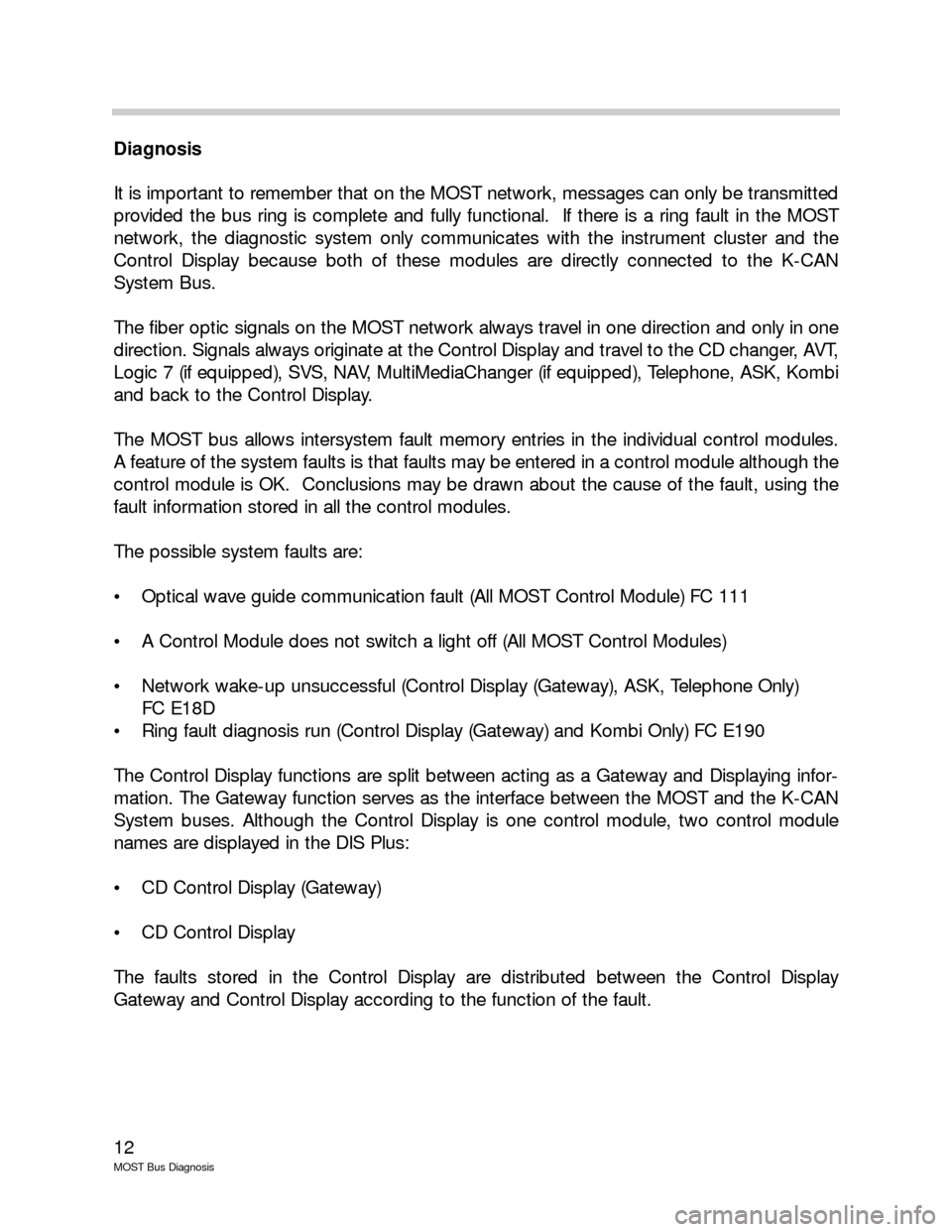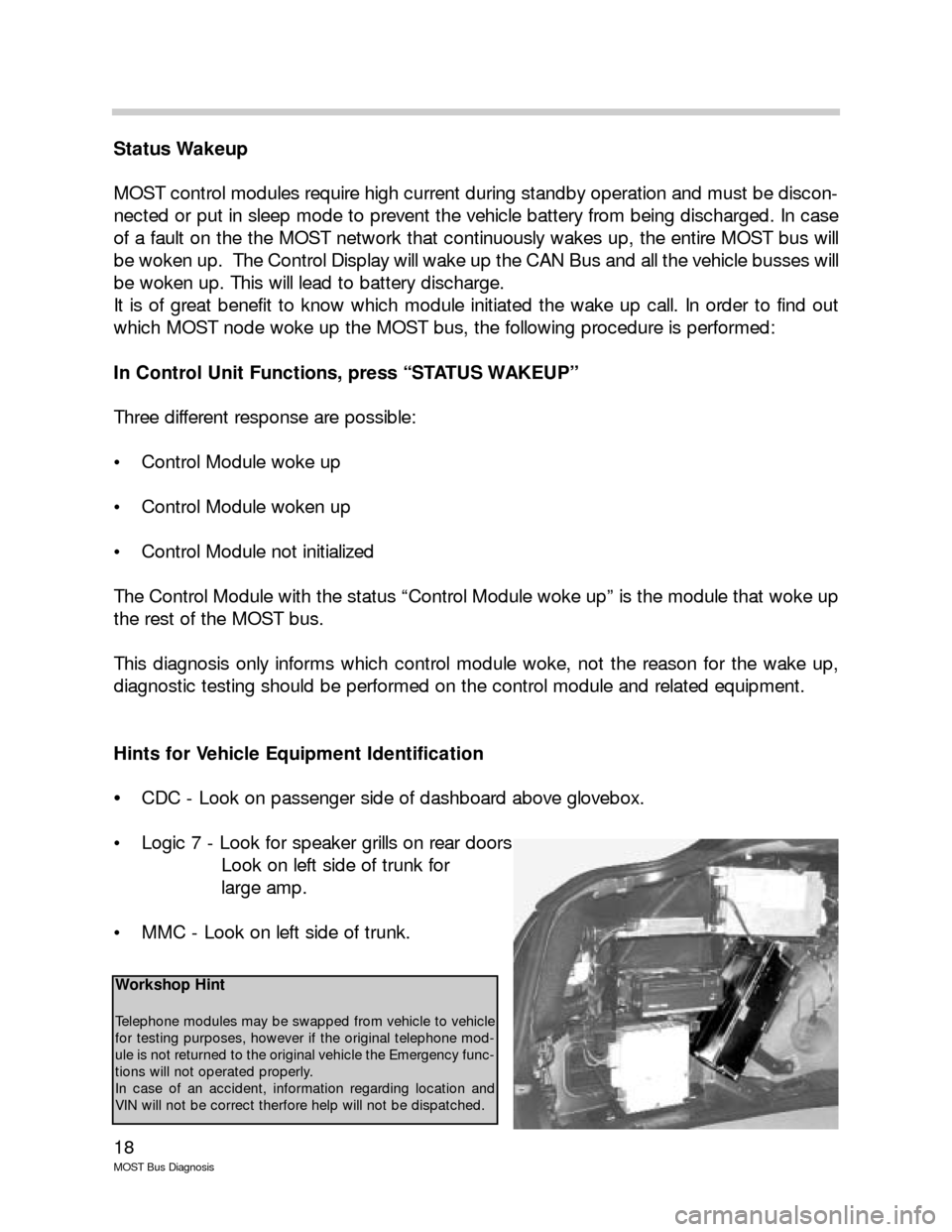phone BMW 7 SERIES 2005 E65 MOST Bus Diagnosis Workshop Manual
[x] Cancel search | Manufacturer: BMW, Model Year: 2005, Model line: 7 SERIES, Model: BMW 7 SERIES 2005 E65Pages: 20, PDF Size: 0.13 MB
Page 10 of 20

10
MOST Bus Diagnosis
CD Changer Audio (CDC)
The CD changer is a slave control unit in the MOST framework.
Navigation System (NAV 01)
The control unit of the navigation system has controller tasks and slave functions in the
MOST framework.
Slave Control Units
The following control units are slave control units:
Kombi (control unit of the instrument cluster)
AVT
LOGIC7
SVS Speech processing system
Telephone
MMC
Component Locations
Located in the dashboard assembly:
Control Display
CD Changer
ASK
Kombi
OPPS Connector
Located in the luggage compartment, rear left:
Logic 7
SVS
NAV
MMC
Telephone
Located in the C pillar left side:
AVT
Page 11 of 20

11
MOST Bus Diagnosis
Communication Direction in MOST structure
Important!!! The component sequence of the MOST controllers in the ETM is incor-
rect when it comes to signal transmission direction. The correct sequence is indi-
cated above!
The signal transmission direction of the MOST in a vehicle
with full equipment takes place starting at the Control
Display and travels serially towards the CD changer,
Antenna tuner, Hi-fi amplifier, Speech Processing Module,
Navigation, Multi-media Changer, telephone, Audio
System Controller, Instrument Cluster and again back to
the Control Display.
Counts as 2Counts as 2
Page 12 of 20

12
MOST Bus Diagnosis
Diagnosis
It is important to remember that on the MOST network, messages can only be transmitted
provided the bus ring is complete and fully functional. If there is a ring fault in the MOST
network, the diagnostic system only communicates with the instrument cluster and the
Control Display because both of these modules are directly connected to the K-CAN
System Bus.
The fiber optic signals on the MOST network always travel in one direction and only in one
direction. Signals always originate at the Control Display and travel to the CD changer, AVT,
Logic 7 (if equipped), SVS, NAV, MultiMediaChanger (if equipped), Telephone, ASK, Kombi
and back to the Control Display.
The MOST bus allows intersystem fault memory entries in the individual control modules.
A feature of the system faults is that faults may be entered in a control module although the
control module is OK. Conclusions may be drawn about the cause of the fault, using the
fault information stored in all the control modules.
The possible system faults are:
Optical wave guide communication fault (All MOST Control Module) FC 111
A Control Module does not switch a light off (All MOST Control Modules)
Network wake-up unsuccessful (Control Display (Gateway), ASK, Telephone Only)
FC E18D
Ring fault diagnosis run (Control Display (Gateway) and Kombi Only) FC E190
The Control Display functions are split between acting as a Gateway and Displaying infor-
mation. The Gateway function serves as the interface between the MOST and the K-CAN
System buses. Although the Control Display is one control module, two control module
names are displayed in the DIS Plus:
CD Control Display (Gateway)
CD Control Display
The faults stored in the Control Display are distributed between the Control Display
Gateway and Control Display according to the function of the fault.
Page 17 of 20

17
MOST Bus Diagnosis
The Control Display will display a relative node number. This number will indicate how many
modules communicated after the module which set the relative node number of 0.
To find the control module with the relative node number of 0, count from the input side of
the Control Display (counting the Control Display as 0) towards the control modules. When
arriving at the control module with the number as displayed as the relative node number in
the DISplus, the last known communicating module has been found.
Example:
While performing the ring break diagnostics the Control Display has set a relative node
number of 2. Count the Control Display a 0, the Kombi will be 1 and the ASK will be 2.
The ring break occurs between the ASK and the module which precedes it, the telephone
module.
Important
When counting control modules, the multimedia changer (if equipped) and the Nav system
must be counted as two control modules.
In order to perform the count correctly the equipment on the vehicle must first be identified.
When using the MOST network diagram in the DISplus, connector number 1 of the optical
waves are inputs and connector number 2 are outputs.
Module input
Terminal 1
Module output
Terminal 2
Module input
Terminal 1
Module output
Terminal 2
12
Workshop Hint
When preparing to initiate a Ring Break Test it is very important that
the removal and reinstallation of the battery cable be quick and with-
out hesitation.
Hesitation removing or replacing the battery cable may cause volt-
age spikes that will render the Ring Break Test void.
Workshop Hint
For repair of MOST optical wave guide use special tools:
61-4-320 Crimping Tool Kit
Refer to
EPC 61_1578 for specific optical wave guide repair parts.
Page 18 of 20

18
MOST Bus Diagnosis
Status Wakeup
MOST control modules require high current during standby operation and must be discon-
nected or put in sleep mode to prevent the vehicle battery from being discharged. In case
of a fault on the the MOST network that continuously wakes up, the entire MOST bus will
be woken up. The Control Display will wake up the CAN Bus and all the vehicle busses will
be woken up. This will lead to battery discharge.
It is of great benefit to know which module initiated the wake up call. In order to find out
which MOST node woke up the MOST bus, the following procedure is performed:
In Control Unit Functions, press “STATUS WAKEUP”
Three different response are possible:
Control Module woke up
Control Module woken up
Control Module not initialized
The Control Module with the status “Control Module woke up” is the module that woke up
the rest of the MOST bus.
This diagnosis only informs which control module woke, not the reason for the wake up,
diagnostic testing should be performed on the control module and related equipment.
Hints for Vehicle Equipment Identification
CDC - Look on passenger side of dashboard above glovebox.
Logic 7 - Look for speaker grills on rear doors
Look on left side of trunk for
large amp.
MMC - Look on left side of trunk.
Workshop Hint
Telephone modules may be swapped from vehicle to vehicle
for testing purposes, however if the original telephone mod-
ule is not returned to the original vehicle the Emergency func-
tions will not operated properly.
In case of an accident, information regarding location and
VIN will not be correct therfore help will not be dispatched.